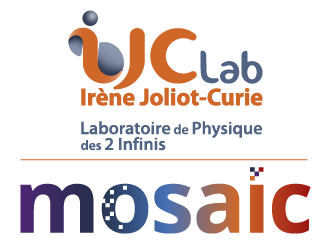Andromede is a 4 MV NEC Pelletron ion accelerator. The voltage can be adjusted from 500 kV to 4 MV. The terminal of this accelerator is designed to receive two kinds of sources, an electron cyclotron resonance (ECR) source and a liquid metal ion source (LMIS). The ECR source is a Microgan manufactured by Pantechnik with a RF frequency of 10 GHz and a magnetic well adjustement allowing the production of multi-charged atomic ions or molecular ions. The LMIS column is an OrsayPhysics filtered column, incorporating the mass selection of ions delivered by the source named NAPIS (Nano Particles Ion Source) which produced atomic ions, cluster and metallic nanoparticles. The available elements are listed here.
Andromede has been in operation since 2017. There are three experimental lines behind the analysis magnet, two of them equipped with diagonostic ion beam for determining position, size and intensity :
- A 90° line dedicating to experiments using atomic and molecular beams ions with light mass (mass-to-charge ratios of less than 70, e.g. Germanium, Ge+) for an acceleration voltage of 4 MV – a beam line has been installed for nuclear astrophysics and astrochemistry,
- A beam line at 1°29 dedicated for surface analysis by nanoparticles, using the spectrometer EVE,
- A third beam line can be made available at 70°.

The core of the initial Andromede project (2011-2020, funded through the Equipex ANR-10-EQPX-23) concerned surface analysis associated with mass spectrometry and ionic imaging with cluster and nanoparticle beams [Eller 2015]. A very good reliability of the machine has been obtained, with excellent beam characteristics, from atomic ion beams to nanoparticle beams with projectiles of several hundred to thousands of gold atoms [Lai 2020].
References:
[Eller 2015] Michael J. Eller, Evelyne Cottereau, Bernard Rasser, Elodie Verzeroli, Benoit Agnus, Gabriel Gaubert, Xavier Donzel, Anne Delobbe, Serge Della-Negra, Andromede project: Surface analysis and modification with probes from hydrogen to nano-particles in the MeV energy range, Nucl. Instr. Meth. Phys. B 365 (2015) 367-370, https://doi.org/10.1016/j.nimb.2015.07.090 [Lai 2020] Thanh Loan Lai, Dominique Jacquet, Isabelle Ribaud, Michael John Eller, Dmitriy Verkhoturov, Emile Albert Schweikert, Luiz Henrique Galvão Tizei, Fuhui Shao, Suheyla Bilgen, Bruno Mercier, Gael Sattonnay, Serge Della Negra, Enhanced sputter and secondary ion yields using MeV gold nanoparticle beams delivered by the Andromede facility, Journal of Vacuum Science & Technology B 38 (2020) 044008 https://doi.org/10.1116/6.0000173For more information: see here







